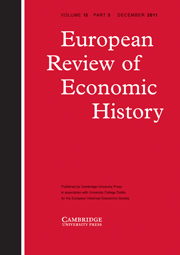Article contents
Putting Spanish steel on the map: The location of Spanish integrated steel, 1880–1936
Published online by Cambridge University Press: 28 November 2002
Abstract
By contrasting the optimal with the actual location of Spain's main production centre in Bilbao, we have tried to resolve the enigma that mislocation introduced an important welfare loss in Spain's industrialisation. This analysis considers the optimal location for integrated steel mills in Spain from their origins (1880s) until the Spanish Civil War (1936–39). The first part of this article introduces the relevant aspects for formalising a model, while Section 2 applies the methodology. The numerical results show how the major technical change – the reduction of coal consumption – affected each of the alternative sites. They also allow us to identify ‘the overall optimum site’, which was not Bilbao. Our final conclusions confirm that the actual centre of iron and steel production during the period considered was a second-best location. The cost in terms of direct welfare loss, in terms of captive markets and rent-seeking used to maintain this second-best solution, and the ultimate consequences of mislocation, point to an inefficiency which has changed the course of modern Spanish industrialisation.
- Type
- Research Article
- Information
- Copyright
- © 2002 Cambridge University Press
- 3
- Cited by


